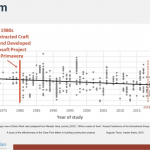I recently spoke to Dr. Barbara Jackson, Director of the Franklin L. Burns School of Real Estate and Construction Management at the Daniels College of Business at the University of Denver. To follow up on her recent talk at Procore’s Groundbreak 2018, I wanted to hear her perspective on the AEC industry, its leadership and current challenges, and what she sees in its future. Our conversation has been lightly edited.
Katherine Van Adzin: Alternative project methods like design-build, IPD, and construction-manager-at-risk have been growing in popularity. Do you think that those encourage innovation for clients more than traditional methods?
Barbara Jackson: Absolutely—100 percent. There’s something very fundamental as to why that’s true, and that is the notion of the low-bid mentality. The thing I’ve said for years is that the worst thing that ever happened to us as an industry, and the greatest barrier to innovation, has been the low-bid mentality. It diminishes every single opportunity to innovate, because when the competitive criteria is simply having the lowest price, there’s absolutely no incentive whatsoever to innovate.
Those who can best innovate for the design and construction process are those who are involved in it. But that siloed design-bid-build group of people are typically creating a design without the benefit of those practitioners who are involved in it every single day, who know what works, who know what doesn’t work, who know where the waste is, who know where the productivity barriers are, but those people are never involved in design-bid-build during the design phase.
The only thing those folks are left to do is to simply deliver per plans and specs. And even if the design team working with a client were trying to incorporate some innovation, they’re not the ones who would know what the greatest innovations might be from a technology perspective, from a mechanical perspective or from a structural perspective. They don’t know. There is so much innovation to be had among the specialty trades, for example, at least in the building process, that never, ever gets tapped into. Alternative project delivery, when it’s set up correctly, gives you a better chance of tapping into that.
In other words, the owner sets it up to capture those great ideas and innovations and productivity improvements in the first place. But one of the challenges I see is that even when an owner will choose an alternative project delivery method, they tweak it so it looks just like design-bid-build, because that’s what they’re used to and that’s what they’re comfortable with. I do believe alternative project delivery, like design-build, CM-at-risk, IPD, or versions of it—that they do provide the opportunity for greater innovation, however, the owner has to be intentional about how they set it up so they can access that innovation.
KV: In your experience, what are the common arguments against implementing alternative project delivery methods?
BJ: Probably the greatest concern that some people have about the alternative approaches is the fear that somehow the owner will lose control of the process, but in reality, it is just the opposite. Because owners have other procurement options other than low bid, such as best value, and qualifications-based selection with alternative delivery approaches, they are no longer at the mercy of selecting their team based upon who is the cheapest. And furthermore, they hire a design AND construction team, and that ability to team from the earliest stages of the design process is what gives the owner even more control—not less.
Another thing I’ve noticed is this vicious circle that the owners and contractors seem to be in. The contractors wish owners would ask them to get involved earlier, and do more than just deliver the budget, schedule, quality and safety—in other words ask them to contribute more innovation and solutions. But they don’t ask, or expect anything more. So that’s all they deliver. But when I talk to the owners, and interview owners, there are many who want much more than that, but their belief is that the contractors can’t deliver anything more, because they never do. Boy, what could be delivered in terms of innovation and solution-finding if we could break this vicious circle of low expectations.
Unfortunately, the traditional relationship between contractors and owners is one of owners not being very trusting of contractors. And it’s such a damaging legacy perception. Contractors believe owners don’t ask them for more, because they’re afraid to reveal too much to them. I’ve heard a few owners say things like, “I don’t want to be in a room full of contractors, it’s like being with a bunch of sharks.” Another remarked, “Don’t you know, contractors are the enemy.” But I truly believe this all stems from a past design-bid-build delivery approach where contractors and owners and architects are pitted against one another. It’s an archaic approach that is the least productive, least collaborative, and least innovative. Truly, it only has use in a commodities environment, and design and construction is NOT a commodity, especially when capital outlays and capital projects are such a vital part of an organization’s or agency’s success. It’s a shame really, that this legacy perception has lasted this long, but unfortunately it still exists and it is a true barrier to improvement in the industry.
And that’s what leads me to suggest that what’s missing is leadership all around. It’s leadership from a contractor perspective and from an owner/client perspective. It’s that notion of taking a stand for doing this business differently. But instead we focus on management of the status quo, trying to best manage within this really, really outdated model that we have that is totally reactive rather than proactive. It’s almost like the game Battleship, where they’re each behind a wall, throwing something over the top to see what the reaction is going to be, instead of taking down the doggone wall, and actually asking, “What is it we’re trying to accomplish here, together?”
And I think that with processes like design-build, when they connect early on, before they even know what they’re going to do, they have a real opportunity to flesh out what’s possible and what the challenges are—I call it challenge-driven design-build. Let’s start at the challenge, instead of waiting until we’ve designed a building or a roadway or a bridge, why don’t we start at the challenge and have a conversation. It blows my mind, and I’ve been in this business a long time, and I had a design-build company myself for many, many years. I’ve worked in traditional construction as an estimator, and a project manager for many years prior. And it just blows my mind that we cannot get past this culture of mistrust. We’re professionals. What other business does this happen in where you hire people that you profess you don’t trust? Why would you do that? Can you imagine if a patient selected a doctor they don’t trust to operate on them?
KV: What kinds of changes do you think there need to be in leadership to shift away from this mentality?
BJ: We need to change our whole perspective of what construction is. I actually wrote a whole chapter in a book called, “It’s Just Construction.” And what I mean by that is that you’d go to a party or event and some people would say, “So what do you do?” And somebody would say, “I’m an attorney” and another person would say, “I’m a doctor,” or “I’m an accountant.” And then you’d say, “I’m a contractor,” and they’d go, “Oh, just construction.” And it really struck me after a while. Do they understand that nothing exists without us? There is no transportation. There is no energy. There is no healthcare. There is no housing. There is no worship. There is no recreation. There is nothing without construction. And do they understand that it’s not architecture until somebody builds it?
Most people do not understand the complexity of what it takes, not just to design something, but to actually execute and deliver and build it. They have no idea of the complexity. So, when I talk about the leadership gap, I’m talking about the need to change the story about the whole industry. Because we’re not seen as an industry that can deliver anything but the tangible product. We never measure our industry from the perspective of its impact, and its impact is huge, but it’s not recognized.
For example, I put this challenge before a group of about 100 AGC Future Leaders Forum attendees. I wanted to hear someone describe a triple bottom line deliverable (economic, environmental, and social), and not just the usual economic performance associated with meeting the budget and schedule. So, I asked about someone’s last project, and they could tell me about the economic performance, and even describe an environmental goal that was achieved. And then I asked, “What was the social performance or the social impact?” And it went silent. So, I asked, “Does anyone in this room drive that bridge that this other contractor said was his last project?” And a young man raised his hand and I asked, “So, what difference has that bridge made to you personally?” And he said, “Well, I get home about twenty-five minutes earlier.” And I asked, “And what difference has that made?” And he had tears in his eyes when he said, “Well, now I get to see my son’s soccer games.” And I said, “And you think it’s just construction!”
The leaders we need are people who understand not just the result or the outcome, but the impact that we have. But I never hear anybody speaking the story of this industry. Leadership, in my view, requires the ability to inspire. The ability to speak a story in such a way that other people can see themselves in it. We think of leadership in construction as just management, maintaining the status quo—achieving budget, and schedule, and quality. I’ve got great friends heading up great companies, and they have done a very good job to maintain the status quo, and to keep their companies out of trouble, mitigate risk, generate profits, serve clients to the highest capability that is traditional, and they’re very good at it. And that’s what leaders in our industry traditionally do. Unfortunately, we need more.
I’m not criticizing, I’m just saying that we are so much more than how we even see ourselves. And at the University of Denver we teach several classes on leadership in different areas. We’re teaching regenerative development for example, completely different ways of thinking about everything. We see the product of construction as just a tiny piece of the ecosystem of the whole business of the built environment. It’s just a tiny piece. So, when we think of projects we’re thinking of not just the spaces we create, but the spaces in between, and how they impact the community, and what happens within them. And we’re teaching them how to speak about that. They’re not just speaking budget, and schedule, and quality and safety. They are talking about impact beyond the delivery of a building or project. We teach strategic foresight. We teach strategic intelligence. We’re teaching them how to think and speak about this business differently.
KV: What led you to identify leadership as an area to change in the industry?
BJ: This has been a passion of mine for some time, but here’s the thing that happened. The reason I took this job at DU was because they were possibly the only construction management program that’s in a true college of business. And I thought, “That’s where the owners are.” If we’re ever going to get to the owners, we need to be engaged with them even at an educational level to combine the money piece of it, the finance, the investment, the development, along with the project delivery and construction management piece. That’s why I came to DU. But we created this very advanced curriculum. And some of the courses were courses like strategic intelligence and foresight. And some of the courses were regenerative development, or what we call city-crafting, and changing that mentality from being a builder to being a community builder. In other words, it’s not just a structure or facility, it’s the whole community and its impact on the community.
Well, after four years, I started getting wind that some of these students, after they graduated, were meeting monthly. They were gathering monthly, together on their own. And I asked them what they were meeting about. And they said, we come out of this program lit up and on fire, and the next thing we know it’s three months later, and the companies that hired us have put out that fire as quickly as they could. And they said to me, “Barb, the companies we want to work for do not exist.”
So that’s what put my total focus on leadership, the innovation gap, culture, shifting the culture, all of those sorts of things because I just can’t see the industry surviving for many more decades. It will survive because we need it, but not in the form that it exists right now.
And so, we have a choice of outsiders coming in and taking this over, or we do it ourselves, and these younger people, they’re staying with their companies, but part of my goal is to create this infrastructure in which these people can work for their companies but then also have a place to go to work on some of these innovations and ideas. This infrastructure will become known as the Innovation Enterprise Network, and it will reside inside a new think tank dedicated to the industry called Spark. The work of Spark will be to develop alternative futures for the construction industry so we can proactively go to work to create a viable path to those futures.
KV: How do you see technology changing the industry?
BJ: I’m not an expert in the technology arena at all, but I can tell you this. One of the things that is amazing to me is how we are still stick-building, and how we haven’t embraced prefabrication. We do a little bit here, a little bit there, but we just have been so slow and resistant. I don’t understand why we’re still stick-building anything, anything at all. I understand that there are building codes and other barriers to advancing technologies, but why aren’t we working on removing the barriers that allow us to begin to utilize robotics, and automation and other types of technology?
We’ve adopted some technology, software to manage collaboration, to manage design, that kind of thing. We’ve made progress there, there’s no doubt. It’s still not commonplace, but it’s becoming more commonplace. We’re finding ways to fine-tune the process. But what I don’t see is a way to fine-tune and improve productivity in a serious way.
I was talking to some industry leaders about 3-D printing of buildings, and when I spoke to a woman from Dubai, I indicated that we can barely get to prefabrication in this country, let alone the idea of 3-D printing buildings. And she said, “Oh, we’re doing it, we have a mandate.” The mandate from the government there is that by something like 2030, thirty percent of all municipal buildings will be 3-D printed. And as I talked to her she pulled up on her computer building after building, and they’re very cool looking. And I said, “So these are in the works?” She said, “No, no, they’re done. We’re using them. We’re working in them.” That is absolutely transformational. And I know there are a lot of barriers to why we’re not doing it. What bothers me is that nobody is working on eliminating the barriers.
For example, the redundancy that exists in our process is unbelievable. Most commercial projects are over-insured by about 350 percent. That is so much waste, it’s unbelievable. The building code, permitting process, the regulatory process, the entitlement process, the financing process, we’re not even looking at any of that. And this is another place where I’m saying leadership is missing. Leadership is missing because those are the big areas. If we look at business as an ecosystem, then we can maybe start to address some of this.
In my presentation at Groundbreak I showed a graphic that came from a 2017 study that basically said construction is just above hunting and agriculture in terms of its application and utilization of digital technology. Our utilization of technology is so limited.
I realize that transition is difficult. Trying to push new ideas and new approaches isn’t easy. When the going gets tough, people go right back to the way they were doing things before. And unfortunately, leadership’s response is often, “Well, okay. I guess that’s all we can do.” But instead we need to stay the course, push the transition forward, we need to figure this out, we need to take the steps, but the challenge with our industry is it’s like a big machine—never stopping, and it can’t stop. I realize that. It’s this machine in which everything is at the mercy of the project level—the schedules, the time frames, the urgency. Projects are the cash machines—they keep the cash flowing and it must flow. Anything that’s going to delay or postpone or hinder the project level has to be sacrificed even if the whole process is inefficient, even if it’s not advanced and we go back to analog. The view is that it’s better to go back to analog and keep the machine moving than to stop the machine. It’s unfortunate—like another vicious circle.
You’ve got to keep the machine moving, I understand that, but while the machine is moving, what else are you doing? What are you investing in? What are you creating? We have to find ways to pilot approaches and processes, and move forward with transforming this industry while keeping the machine going. It’s not easy, but that’s the kind of leadership that I say is missing.
Here’s the thing, there are younger people who are starting to step away from the traditional companies. At some point, they’re going to start to come together. If they’re going to stay in this business at all, the intention is to create it a different way. I’ve seen it happen now two or three times, and I’m flat out betting that it’s going to happen, that they will be the ones who transform it, or they’re going to get out of it altogether. It won’t be the companies we know today that will make these changes. It will be the newer, upcoming companies, because you can’t stop the machine. They have no mechanism for doing that. And if you’re not preparing for that, the disruption that these young people are going to cause, or the disruption that is already starting to be felt from people completely outside of the industry, it is going to hit you like a rock.
About Dr. Jackson
After twenty years in industry as a chief estimator, senior project manager, and CEO of Design-Build Services Inc., and another fifteen years developing design-build and integrated project delivery education at Cal Poly in San Luis Obispo CA, Barbara has returned to Colorado, where in August of 2013, she took over the helm as the Director of the Burns School of Real Estate and Construction Management at the University of Denver, in Denver, CO. There she has developed an educational model representing the full life-cycle of the built environment, and one of the most advanced Master’s degrees in Integrated Project Delivery, with an emphasis on Leadership. She also established the Center for Integrated Solutions for the Built Environment (CISBE).
As one of the most recognized and respected thought leaders in the AEC industry, Dr. Jackson’s primary focus is on leadership and culture in the transforming design and construction disciplines. She is a leading expert in the area of integrated project delivery, design-build project management, interdisciplinary collaboration, and integrated project leadership. Dr. Jackson spent 20 years in the construction industry working as a project estimator and senior project manager and then as President and Owner of Design/Build Services Inc. She holds a B.S. in Housing and Design, a Masters in Construction Management, and a Ph.D. in Education and Human Resources with a specialization in Technology of Industry from Colorado State University. Dr. Jackson received a Design-Build Distinguished Leadership Award in 2001 and 2002, and the DBIA Distinguished Service Award in 2005. She continues to serve DBIA in various capacities. Dr. Jackson is a nationally recognized speaker on design-build project delivery, integrated project leadership, transforming culture of the AEC industry, and high-performance design-build teams. She also provides private consulting services and training to the industry.
She is probably best known for her work associated with Making the Mental Shift to Design-Build, Transforming Culture in the AEC Industry, Developing the Integrated Design-Build/IPD Ready Team, Why Women-Why Now in the AEC Industry, and Leadership Matters. Always in high demand, she presents the most innovative and thought-provoking industry material to a multitude of regional, national and international design and construction companies, professional associations, and public entities each year.
Dr. Jackson facilitates an annual three-day intensive Women in Construction Leadership Bootcamp attended by women from across the US. She is also the author of two books—Construction Management Jumpstart and Design-Build Essentials.










